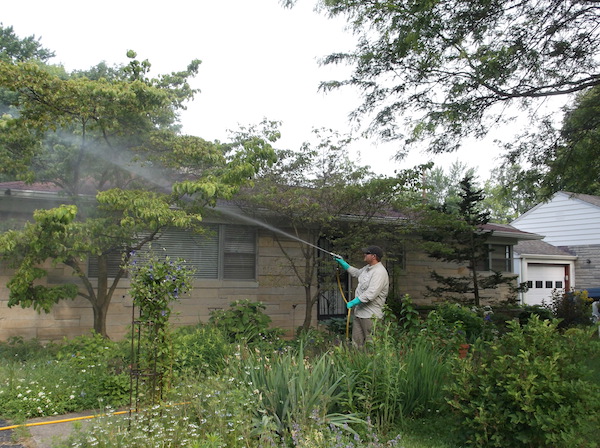
Leaves from this native dogwood (Cornus florida) were sent to Purdue University’s Plant Pest Diagnostic Laboratory. The diagnosis: dogwood anthracnose had infested the tree (Cornus florida). (C) Jo Ellen Meyers Sharp
The other day while gazing out my front window, I noticed the leaves on one of the two flowering dogwood trees looked very small. I darted out of the house to get a close look and was shocked to see most of the leaves were brown and curling. The flower petals, called bracts on dogwoods, were shriveled and the ground was covered with their bits and pieces.
Oh, dear, I thought. I wonder if this could be dogwood anthracnose, a fungus disease that I have only read about.
I snipped off some leaves, put them in a disposable plastic container, boxed it up and mailed it off to Purdue University’s Plant Pest Diagnostic Lab (http://bit.ly/2qEo6p2) along with an $11 check and a form that described symptoms, size of tree and other details.
Two days later, I got the results: two types of fungus, dogwood anthracnose and spot anthracnose, with the first one causing the most damage.
Dogwood anthracnose can be a deadly disease on this much-loved native tree (Cornus florida). Not only does the fungus deform leaves, it attacks the twigs, and if it spreads to branches or the trunk, the tree is likely a goner.
“Dogwood anthracnose (Discula destructiva) initially causes spotting and blotches on bracts and leaves and later moves into small twigs. Unless pruned out the infection will move into larger branches and eventually lead to cankers on the main trunk which can kill the entire tree,” the report said. That must be the destructiva part of the scientific name, I thought.

Pete Fife of Vine and Branch sprayed a fungicide of two native dogwoods to control dogwood anthracnose. The fungus disease could kill the tree if left untreated. (C) Jo Ellen Meyers Sharp
The lab recommends pruning out all dead wood and burn or bury material. Putting the wood out with the trash in Indianapolis will get it burned. Water during prolonged dry periods in summer to avoid drought stress, but avoid wetting the foliage. Spray with a fungicide to protect new growth. Trees with large trunk lesions or cankers can’t be saved and should be removed and burned or buried to reduce.
“We have had several calls and emails about dogwood recently but most of that has been related to cold damage in the northern part of the state,” said Tom Creswell, director of the lab. “I believe newly emerged leaves were stressed by a cold rainy period and the damage took a while to be noticed.”
The two dogwoods have been in this bed, heavily under planted with shade-tolerant perennials since 1999, and this is the first time I’ve had a problem. The tree affected is in more shade than its neighbor, which could account for its severity. I’ve hired a certified arborist to treat both trees with a fungicide this year and hope it is a one-time problem brought on by just the right environmental conditions.